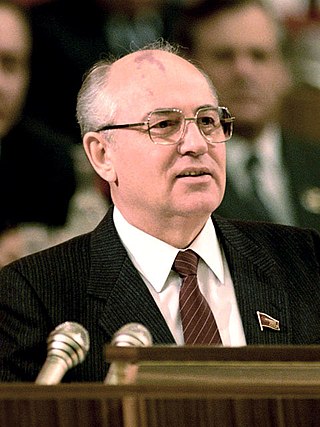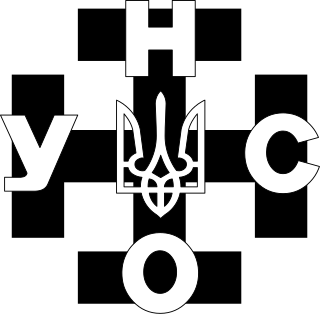
Mikhail Sergeyevich Gorbachev was a Soviet and Russian politician who served as the last leader of the Soviet Union from 1985 to the country's dissolution in 1991. He served as General Secretary of the Communist Party of the Soviet Union from 1985 and additionally as head of state beginning in 1988, as Chairman of the Presidium of the Supreme Soviet from 1988 to 1989, Chairman of the Supreme Soviet from 1989 to 1990 and the only President of the Soviet Union from 1990 to 1991. Ideologically, Gorbachev initially adhered to Marxism–Leninism but moved towards social democracy by the early 1990s.
1990 (MCMXC) was a common year starting on Monday of the Gregorian calendar, the 1990th year of the Common Era (CE) and Anno Domini (AD) designations, the 990th year of the 2nd millennium, the 90th year of the 20th century, and the 1st year of the 1990s decade.

The president of the Soviet Union, officially the president of the Union of Soviet Socialist Republics, abbreviated as president of the USSR, was the head of state of the Union of Soviet Socialist Republics from 15 March 1990 to 25 December 1991.

The Communist Party of Turkmenistan was the ruling communist party of the Turkmen SSR, and a part of the Communist Party of the Soviet Union. From 1985 it was led by Saparmurat Niyazov. 16 December 1991, as the Soviet Union was in the process of dissolving, Niyazov reorganized the CPT as the Democratic Party of Turkmenistan. The current Communist Party of Turkmenistan was made illegal during the presidency of Niyazov after independence and remains banned.

The Mongolian People's Party (MPP) is a social democratic political party in Mongolia. It was founded as a communist party in 1920 by Mongolian revolutionaries and is the oldest political party in Mongolia. The party played an important role in the Mongolian Revolution of 1921, which was inspired by the Bolsheviks' October Revolution. Following independence, it governed Mongolia as a one-party socialist state. The party changed its name to the Mongolian People's Revolutionary Party (MPRP) and joined the Communist International in 1924 and served as a sole-ruling party of the Mongolian People's Republic.

The Communist Party of Thailand was a communist party in Thailand active from 1942 until the 1990s.
The People's Movement of Ukraine is a Ukrainian political party and first opposition party in Soviet Ukraine. Often it is simply referred to as the Movement. The party under the name Rukh was an observer member of the European People's Party (EPP) until 2013. It is considered to have played a key role in Ukraine regaining its independence in 1991.

The Communist Party of Tajikistan is a communist party in Tajikistan, and the oldest political party in the country. The party was founded on 6 January 1924 and was the ruling party of the Tajik Autonomous Soviet Socialist Republic from 1924 to 1929 and the Tajik Soviet Socialist Republic from 1929 to 1990 as part of the Soviet Union as a republican branch of the Communist Party of the Soviet Union. It was banned in 1991 following the 1991 coup.

The time period of around 1985–1991 marked the final period of the Cold War. It was characterized by systemic reform within the Soviet Union, the easing of geopolitical tensions between the Soviet-led bloc and the United States-led bloc, the collapse of the Soviet Union's influence in Eastern Europe, and the dissolution of the Soviet Union in 1991.

The Communist Party of Lithuania was a communist party in Lithuania. The party was established in early October 1918 and operated clandestinely until it was legalized in 1940 after the Soviet invasion and occupation. The party was banned in August 1991, following the coup attempt in Moscow, Soviet Union which later led to the collapse of the Soviet Union and the dissolution of the Lithuanian SSR.

The Revolutions of 1989, also known as the Fall of Communism, was a revolutionary wave of liberal democracy movements that resulted in the collapse of most Marxist–Leninist governments in the Eastern Bloc and other parts of the world. Sometimes this revolutionary wave is also called the Fall of Nations or the Autumn of Nations, a play on the term Spring of Nations that is sometimes used to describe the Revolutions of 1848 in Europe. It might have contributed to the eventual dissolution of the Soviet Union—the world's largest communist state—and the abandonment of communist regimes in many parts of the world, some of which were violently overthrown. The events, especially the fall of the Soviet Union, drastically altered the world's balance of power, marking the end of the Cold War and the beginning of the post-Cold War era.

The Ukrainian National Assembly – Ukrainian People's Self-Defence is a Ukrainian ultra-nationalist organisation. It was composed by a political wing and a paramilitary wing.

The Declaration "On the Restoration of Independence of the Republic of Latvia" was adopted on 4 May 1990 by the Supreme Soviet of the Latvian SSR in which Latvia declared independence from the Soviet Union. The Declaration stated that, although Latvia had de facto lost its independence in 1940, when it was annexed by the Soviet Union, the country had de jure remained a sovereign country as the annexation had been unconstitutional and against the will of the Latvian people.

Supreme Soviet elections were held in the Ukrainian SSR on 4 March 1990, with runoffs in some seats held between 10 and 18 March. The elections were held to elect deputies to the republic's parliament, the Verkhovna Rada. Simultaneously, elections of oblast councils also took place in their respective administrative divisions.

The Mongolian Revolution of 1990, known in Mongolia as the 1990 Democratic Revolution, was a peaceful democratic revolution which led to the country's transition to a multi-party system. It was inspired by the economic reforms of the Soviet Union in the late 1980s and was one of the many revolutions of 1989. It was led mostly by young demonstrators who rallied at Sükhbaatar Square, in the capital city Ulaanbaatar. The main organisers of the demonstrations included Sanjaasürengiin Zorig, Erdeniin Bat-Üül, Davaadorjiin Ganbold, Tsakhiagiin Elbegdorj, Bat-Erdeniin Batbayar.

The 1st Czechoslovak Army Corps, also known as Svoboda's Army, was a military formation of the Czechoslovak Army in exile fighting on the Eastern Front alongside the Soviet Red Army in World War II.

Supreme Soviet elections were held in the Tajik SSR on 25 February 1990. The Communist Party of Tajikistan was the only legal political party at the time, with only independent candidates contesting seats. The CPT won 96% of the 230 seats in the Supreme Soviet.

The dissolution of the Soviet Union was the process of the disintegration of the Soviet Union (USSR), which resulted in the end of the country as a sovereign state and its federal government, which in turn resulted in its 15 constituent republics gaining full independence on 26 December 1991. It brought an end to General Secretary Mikhail Gorbachev's effort to reform the Soviet political and economic system in an attempt to stop a period of political stalemate and economic backslide. The Soviet Union had experienced internal stagnation and ethnic separatism. Although highly centralized until its final years, the country was made up of 15 top-level republics that served as homelands for different ethnicities. By late 1991, amid a catastrophic political crisis, with several republics already departing the Union and the waning of centralized power, the leaders of three of its founding members declared that the Soviet Union no longer existed. Eight more republics joined their declaration shortly thereafter. Gorbachev resigned in December 1991 and what was left of the Soviet parliament voted to end itself.

The communist insurgency in Thailand was a guerrilla war lasting from 1965 until 1983, fought mainly between the Communist Party of Thailand (CPT) and the government of Thailand. The war began to wind down in 1980 following the declaration of an amnesty, and in 1983, the CPT abandoned the insurgency entirely, ending the conflict.

The Supreme Soviet of the Tajik SSR was the supreme soviet of the Tajik SSR, one of the republics comprising the Soviet Union. The Supreme Soviet had very little power and carried out orders given by the Communist Party of Tajikistan (CPT), until democratic elections held during glasnost and perestroika.


















